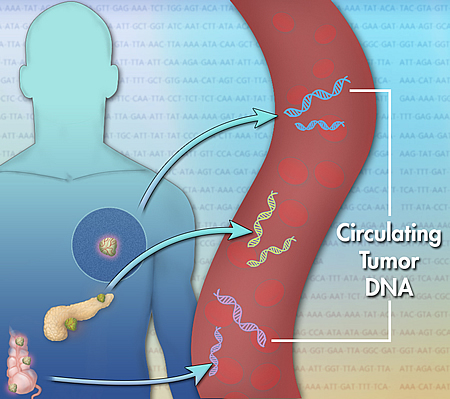
Source: NIH
Minimal and noninvasive techniques to detect and track the progression of diseases such as cancer are beginning to have a significant impact on the clinical diagnostic landscape. Tissue analysis always presents an array of limitations and challenges, especially for a small, tucked away organ such as the pancreas. Investigators from Sorbonne University in Paris have now assessed the feasibility and the prognostic value of circulating tumor DNA (ctDNA) in pancreatic adenocarcinoma.
The incidence of pancreatic adenocarcinoma is on the rise in many Western countries, and prognosis remains very poor. Pancreatic cancer is projected to become the second leading cause of cancer-related death in the United States by 2030, behind lung cancer, and is therefore considered a significant public health problem.
Unfortunately, there are several challenges to conducting translational research on pancreatic cancer, including the difficulty in obtaining tumor samples from patients, since most studies have been limited to patients with the resectable disease until now. However, only 10% to 15% of patients with pancreatic adenocarcinoma have resectable disease at diagnosis—making identification of robust prognostic or predictive biomarkers critical for all patients with pancreatic adenocarcinoma, whatever the stage of the disease.
For the current study, the French investigators initiated their research 5 years ago to collect blood samples from patients with pancreatic adenocarcinoma, with the goal of identifying blood-based biomarkers to overcome the challenge of limited availability of tumor samples for research purposes.
The Sorbonne team analyzed blood samples from 135 patients with pancreatic adenocarcinoma—31 had resectable tumors, 36 had locally advanced disease (LA), and 68 had metastatic disease (M). They extracted DNA from the plasma samples and used a specific next-generation sequencing (NGS) analysis method to detect low allele-frequency mutations. They also screened all plasma samples for the three most frequent KRAS mutations in pancreatic adenocarcinoma, besides several other mutations, by droplet-based digital PCR (dPCR).
The findings from this study were published recently in Clinical Cancer Research in an article entitled “Plasma Circulating Tumor DNA in Pancreatic Cancer Patients Is a Prognostic Marker.”
“Our study confirms, in one of the largest reported series, the feasibility of detecting ctDNA in patients with pancreatic adenocarcinoma using a specific NGS analysis method that allows us to screen a large number of genes,” explained senior study investigator Jean-Baptiste Bachet, M.D., Ph.D., physician in the gastroenterology and digestive oncology department at Sorbonne University and the Centre Universitaire des Saints-Pères. “Our study also confirms the strong prognostic value of the presence of ctDNA and its level, when detected, in advanced pancreatic adenocarcinoma.”
In multivariate analysis, the presence of ctDNA was an independent prognostic biomarker in patients with advanced disease, and it also correlated with the stage of the disease and the grade of tumor differentiation. Out of the 104 patients with advanced disease, 50 had detectable ctDNA (LA, 17%; M, 65%). After a median follow-up of 34.2 months, 76 died. Overall survival (OS) was 19 months in patients with no detectable ctDNA, versus 6.5 months in those with ctDNA.
Additionally, when patients with advanced disease were grouped into tertiles based on the frequency of mutations in the ctDNA, there was a significant dose–response relationship with OS: 18.9 months for those in the lowest tertile, 7.8 months for those in the middle, and 4.9 months for those in the highest tertile.
Of the 31 patients with resectable disease, six had detectable ctDNA. After a median follow-up of 33.3 months, 23 had disease recurrence, and 13 of them died. Disease-free survival was 17.6 months in patients with no detectable ctDNA, versus 4.6 months in those with ctDNA; OS was 32.2 months versus 19.3 months.
Interestingly, the research team found a strong correlation between the results obtained with NGS and droplet-based digital (ddPCR) to study KRAS, confirming that their NGS strategy is pertinent.
“Our results demonstrate the utility of circulating biomarkers in subclassifying cancers and managing treatment,” Dr. Bachet concluded. “We need to confirm these results in prospective clinical trials to better assess the predictive value of this biomarker in light of the dynamic biological changes that occur during treatment.”






